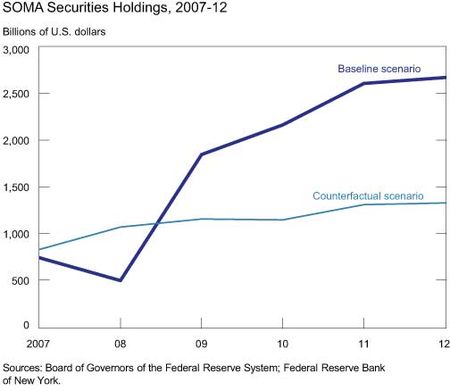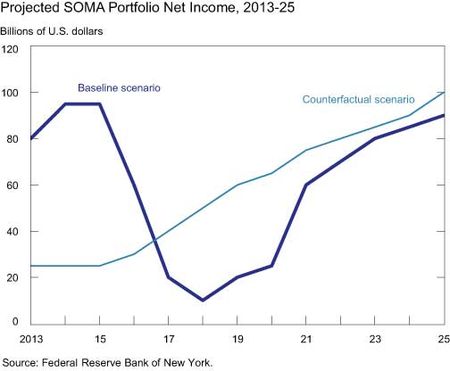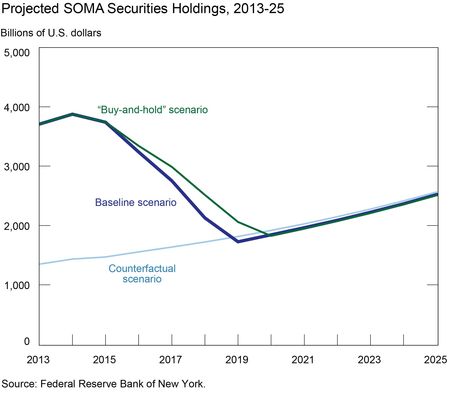Michael
J. Fleming, Deborah Leonard, Grant Long, and Julie Remache
The
Federal Open Market Committee (FOMC) has actively used changes in the size and
composition of the System Open Market Account (SOMA) portfolio to implement monetary
policy in recent years. These actions have been intended to promote the Committee’s
mandate to foster maximum employment and price stability but, as discussed in a
prior post, have also generated high levels of portfolio
income, contributing in turn to elevated remittances to the U.S. Treasury. In
the future, as the accommodative stance of monetary policy is eventually
normalized, net portfolio income is likely to decline from these high levels
and may dip below pre-crisis averages for a time, potentially contributing to a
suspension in remittances (Carpenter
et al. 2013). But what would the path of the
portfolio and income look like had these unconventional balance sheet actions not
been taken? In this post, we conduct a counterfactual exercise to explore such
a scenario.
Our counterfactual scenario assumes
that the Fed responded to the financial crisis only by lowering the federal funds
target rate. That is, no unconventional changes were made to the size or
composition of the portfolio, and no credit or liquidity facilities were set up.
As such, from August 2007, the counterfactual SOMA portfolio remains an
all-Treasury portfolio that grows roughly in line with currency in circulation.
We compare this to the “baseline” scenario from the New York Fed’s report Domestic Open Market Operations during 2012,
which reflects actual balance sheet developments through December 31, 2012, and
a projected portfolio path, based on primary dealer expectations from the
Desk’s Survey of Primary Dealers and the exit strategy principles articulated
in the June 2011 FOMC minutes (including mortgage-backed-security sales), after
that. Other Fed balance sheet items follow trend growth, consistent with the
projection methodology detailed in Carpenter
et al. 2013.
An important and artificial
simplifying assumption is that interest rates follow the same path for the
baseline and counterfactual scenarios. That is, under both scenarios, we apply
actual market interest rates through the end of 2012 and assume a future path
of short- and long-term interest rates after that, drawn from publicly
available surveys. In fact, long-term interest rates may have been higher or
lower in the absence of unconventional monetary policy. For example, it’s
plausible that the Fed would have maintained the same exceptionally low
short-term interest rates through the crisis and its aftermath, but that the
absence of the Fed’s large-scale asset purchases would have resulted in higher
long-term interest rates. Alternatively, economic and financial conditions
might have recovered even more slowly in the absence of unconventional policy,
contributing to a lower path for long-term rates. Given the difficulty of
estimating what rates would have been under the counterfactual, we make the simplifying
albeit fictitious assumption that rates would have been the same.
SOMA Securities Holdings
Under the counterfactual scenario, SOMA domestic securities holdings—consisting
entirely of Treasury securities—were $1.3 trillion as of year-end 2012, or roughly
$1.4 trillion lower than the baseline’s $2.7
trillion portfolio,
composed of Treasuries, agency debt, and agency mortgage-backed securities (see
chart below). The Treasury holdings of the counterfactual portfolio, which
maintains the pre-crisis allocation of one-third in Treasury bills, had a weighted
average maturity (WAM) of 5.4 years as of year-end 2012, similar to the WAM of
the outstanding supply of Treasury securities, but significantly shorter than the
WAM of 10.4 years of the baseline portfolio’s Treasury holdings.
Going forward, we project the counterfactual
portfolio to continue to grow steadily, in line with currency growth, through
the end of our forecast horizon in 2025. In contrast, the baseline portfolio is
projected to follow a more varied contour, rising to a peak of nearly $3.9
trillion in early 2014 following the completion of the asset purchases assumed in
this scenario. Portfolio balances remain elevated through early 2015 before
declining steadily through a combination of redemptions and asset sales during
the policy normalization period (drawn from the FOMC’s June 2011 exit strategy principles).
The sizes of the two portfolios roughly converge in 2019. Although the baseline
portfolio returns to a nearly all-Treasury composition in 2021, the composition
of its securities holdings still has a slightly higher WAM than the counterfactual
portfolio because of the longer-term Treasury securities that were purchased in
recent years.
Portfolio Income
What about the income generated by the SOMA portfolio? We estimate relatively
steady net income under the counterfactual scenario, averaging approximately $27
billion annually from 2008 to 2012 (see chart below). In actuality, as seen in
the baseline, the FOMC’s efforts to provide additional accommodation through
use of the SOMA portfolio contributed to rising levels of net portfolio income over
this period, peaking at almost $90 billion in 2012. The lower level of income
during the crisis under the counterfactual scenario reflects the shorter
maturity structure and smaller size of the counterfactual portfolio.
However, the baseline portfolio is not expected to continue generating such high income as the stance of monetary
policy is eventually normalized. Under the assumptions in the baseline
scenario, portfolio net income is projected to fall beginning in 2016 and to
remain low for several years. This reflects the interplay of several factors,
including higher interest payments on excess reserve balances as interest rates
rise, declining interest income as the size of the portfolio returns to lower
levels, and realized capital losses as agency mortgage-backed securities are
sold.
In contrast, portfolio income
associated with the counterfactual SOMA portfolio is projected to grow (from
dampened levels) as policy normalization takes place. Because this portfolio is
heavily invested in shorter-term Treasury securities, it sees interest income increase
as the portfolio rolls over in an environment of rising interest rates. Moreover,
because the portfolio is funded primarily with currency, it has only minimal
interest expense associated with reserves. Income associated with both
portfolios is expected to converge roughly to the same path late in our
projection period. By then, the baseline scenario returns to a “steady state”
in which its holdings are predominantly Treasury securities and its size once
again roughly matches currency.
Remittances to the Treasury
Fed income—after covering operating costs, dividends, and capital
maintenance—is remitted to the Treasury. The high levels of income that have
been generated by the SOMA portfolio, as well as non-SOMA sources of income
from the various credit and liquidity programs established during the crisis,
have contributed to elevated remittances to the Treasury since the crisis. At
$325 billion, cumulative remittances from year-end 2007 through year-end 2012
are roughly $240 billion higher than the estimated $85 billion of cumulative
remittances under the counterfactual scenario. This difference arises despite higher
interest costs incurred from funding the larger securities portfolio with
excess reserves.
Going forward, should the Fed not
generate sufficient income to cover its operating costs, dividends, and
transfers to capital, it would book a deferred asset (reported for
presentational convenience as a negative liability on the H.4.1 statistical release)
and temporarily halt remittances to Treasury. The deferred asset represents the
value of earnings that would have to be accrued over time to cover that shortfall, and it would have to be paid down before remittances could resume. Declines in net portfolio
income in our baseline scenario suggest the possibility of a deferred asset and
halt in remittances for several years. With a steadier projected path for the
portfolio and income, the counterfactual scenario would avoid that outcome.
Nonetheless, the
baseline portfolio is projected to remit a cumulative total of $820 billion to the Treasury
from 2008 through 2025, or $315 billion more than in the counterfactual
scenario. This arises from its higher overall income, even if the timing of how
it is remitted over the course of the period is less smooth than in the
counterfactual.
Our estimates of Fed income and
remittances under the counterfactual are necessarily rough as they depend on
various assumptions mentioned earlier, including the unrealistic assumption
that interest rates would have been the same in the counterfactual. In
practice, rates would likely have been considerably different if the FOMC had
not responded as forcefully as it did in recent years. Moreover, when
considering the net effects of monetary policy on the government’s fiscal
position, one should also account for the lower borrowing costs and support for
the economic recovery the Fed’s actions have produced, a point addressed in tomorrow’s
post. Nonetheless, our findings broadly highlight the wide margin by which unconventional
monetary policy has boosted cumulative remittances to the Treasury in recent
years.
Addendum
(August 23, 2013)
The above analysis presented the same baseline scenario as
shown in the New York Fed’s April 2013 report, Domestic
Open Market Operations during 2012. That scenario projected a portfolio
path based on roughly $1.1 trillion in asset purchases between 2013 and early
2014, drawn from the Desk’s December
2012 post-FOMC “Survey of Primary Dealers.” It followed the exit strategy
principles outlined in the FOMC’s June 2011 minutes, including the anticipated
sale of agency MBS assets during policy normalization, which was the most
current guidance on the topic at the time of the report’s drafting. Since then,
the minutes of the June 2013 FOMC meeting noted that most FOMC participants now
anticipate that the Federal Reserve would not sell agency MBS as part of the
process of normalizing the size of the balance sheet, although some
participants indicated that limited sales might be warranted in the longer run
to reduce or eliminate residual holdings. The annual report also considered an
alternative “buy-and-hold” scenario that illustrates how the baseline balance
sheet and income projections change in the case of no asset sales.
As shown in the charts below, the differences in portfolio and income effects
associated with specific choices regarding MBS assets during the normalization
process are relatively small compared to the effects that either of these
scenarios have relative to the counterfactual and that have already been
realized since the initiation of LSAPs in late 2008. With no asset sales, ceteris paribus, the general contours of
the portfolio’s size and income are projected to follow similar overall paths
as the baseline. However, the buy-and-hold portfolio is expected to take
slightly longer to converge in size with the counterfactual portfolio, at which
time its size once again roughly matches currency levels. Importantly, its composition
includes significant holdings of both agency MBS and Treasury securities. A
buy-and-hold scenario avoids capital losses on agency MBS sales but has higher
interest expense from additional reserve balances associated with a larger
portfolio, on net resulting in higher portfolio net income over the medium term
compared to the baseline and leading to roughly $55 billion cumulatively in
additional remittances to the Treasury. These are, of course, merely
illustrative projections. Actual future income and remittances will be
influenced by the ultimate size of the purchase program, as well as other
balance sheet, interest rate, and economic developments.
Disclaimer
The views expressed in this post are those of the authors and do not necessarily reflect the position of the Federal Reserve Bank of New York or the Federal Reserve System. Any errors or omissions are the responsibility of the authors.

Michael J. Fleming is a vice president
in the Federal Reserve Bank of New York’s Research and Statistics Group.
Deborah Leonard is an assistant vice president in the Markets Group.
Grant Long is an associate in the Markets Group.

















 RSS Feed
RSS Feed Follow Liberty Street Economics
Follow Liberty Street Economics
We have updated our post with the addendum above.